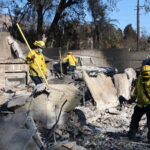RSA Marketing Services has added a new service to its business that it calls Tropic Thunder.
Tropic Thunder is an unmanned aerial vehicle, or drone.
RSA chief executive Bruce Rowley said the types of photos and videos that a drone can capture is something the advertising and marketing firm’s clients had been requesting, The Wichita Eagle reported.
“We had about a dozen clients in the last year asking us if we could bring in a drone to get a certain shot,” he said. “People are used to seeing the kind of shots you can only get with a drone.”
The operation of small drones like Tropic Thunder is murky.
In the past couple of years, the proliferation and operation of drones have drawn scrutiny from the Federal Aviation Administration, which is in the process of finalizing rules for the commercial operation of the craft, which can be purchased for as little as $200.
That final rule-making process is likely months – maybe even years – away, which is complicating things for local companies that design, build and sell unmanned aerial systems. The drones typically use specialized equipment or are designed for special purposes – from aiding emergency responders at a fire scene or checking fields of corn for disease or insects.
At the same time, the safe operation of small drones is, at the moment, the centerpiece of drone research for scientists at Wichita State University’s National Institute for Aviation Research.
Les Dorr, an FAA spokesman in Washington, D.C., said that even with the absence of rules on commercial operation of small drones – the FAA considers a small drone as one that weighs less than 55 pounds – “that doesn’t mean there are no rules.”
For example, individuals operating a small drone for even recreational purposes are prohibited from flying it higher than 400 feet or above people or moving cars. They also are supposed to maintain sight of the drone. More guidelines for recreational operation of small drones are available at knowbeforeyoufly.org, a website the FAA launched as part of its small-drone rule-making.
“For any other purpose, including anything tangentially connected to a business operation, you need FAA authorization of some sort,” Dorr said.
That authorization comes in the form of applying for a Section 333 exemption. Section 333 governs commercial operations of unmanned aerial systems, and part of its requirement is that the pilot of a small drone hold a recreational or sport pilot certificate. Those certificates, while less costly and time consuming than a private pilot certificate, still require classroom time, flying with an instructor and completion of a solo flight.
Dorr said in instances in which businesses are operating small drones commercially without an exemption – the FAA has received 2,000 requests for exemption and has processed about 600 of them, he said – his agency tries to be “friendly” in its first contact with the business.
“The first thing we do is reach out to the operator and educate them on what the rules are,” Dorr said.
In most instances, he said, the operator agrees to comply, and the FAA doesn’t need to take additional action, such as issuing an enforcement letter or, in an extreme cases, issuing a civil penalty against the operator.
Dorr said implementation of the final rule on small unmanned aerial vehicles will take time. The FAA is now working through 4,555 comments made on the proposed rule, which closed for comment on April 24. The agency already is years late in meeting its deadline for developing the rules.
“We cannot guarantee” when the final rule will be issued, Dorr said, but “it is a priority for the final rule to get implemented. We want to make sure we get it right.”
The FAA’s February announcement of the proposed small-drone rule-making has slowed work at John Martens’ company, NMotion UAS, a Wichita-based startup offering unmanned aerial vehicle systems – drones and specialized equipment – to public safety and emergency management agencies, including police, fire and hazardous materials units.
“Kind of all along we’ve had to be pretty careful,” Martens said, “making sure we’re not operating commercially without an exemption.”
Martens said NMotion has applied for an FAA exemption.
“That’s kind of been a challenge for everybody” in the drone business, he said, but “I totally support a policy that’s concerned with safety.”
Until there’s more clarity on small drones, Martens said, the focus will be on networking with potential customers at trade shows and educating public safety agencies on the use of NMotion’s products and services.
“There’s a lot of things we can do while we’re waiting that can accelerate our growth,” he said.
Safety issues will likely drive research on drones at Wichita State’s NIAR, said Tom Aldag, research and development director.
In May, the NIAR and WSU were named by the FAA to a team of universities that would support research at a new National Center of Excellence for Unmanned Aircraft Systems. The center will be led by and based at Mississippi State University but will include research from WSU and 17 other universities in 13 states and the United Kingdom.
Aldag said one area of research proposed by the NIAR as part of the new team is on the effects of collisions between small drones and aircraft – general aviation airplanes, business jets, commercial airliners and helicopters.
“Airborne collisions is one of the concerns we hear,” he said. “What happens if somebody doesn’t follow the rules and happens to get these (drones) into airspace where other airplanes are flying?”
Aldag said the research project likely would include analytical computer modeling of collisions between a variety of aircraft and drones.
“We can get some very good results from that,” he said. “We can turn that around very quickly.”
A second part of that research would likely involve using real drones and crashing them into aircraft parts such as windshields and leading edges of aircraft wings.
“There’s a lot we’re going to look at,” he said.
Other drone-related research at the NIAR includes a partnership with Kansas State University-Salina on a project studying the effects of signals emitted from broadcasting antennas and radio stations on the operation of drones.
“It’s starting to pick up,” Aldag said of drone research projects. “It’s (the drone industry) kind of evolving at the speed of computers. We’re getting involved much more than we were several years ago.”
Was this article valuable?
Here are more articles you may enjoy.

 New Fire Maps Put Nearly 4M Californians in Hazardous Zones
New Fire Maps Put Nearly 4M Californians in Hazardous Zones  Wall Street Brokers Start Trading Insurer Claims From LA Fires
Wall Street Brokers Start Trading Insurer Claims From LA Fires  Ticketmaster May Have Broken Law With ‘Platinum’ Oasis Seats
Ticketmaster May Have Broken Law With ‘Platinum’ Oasis Seats  Scammers Are Pushing Auto Loan Fraud to Record Levels
Scammers Are Pushing Auto Loan Fraud to Record Levels 